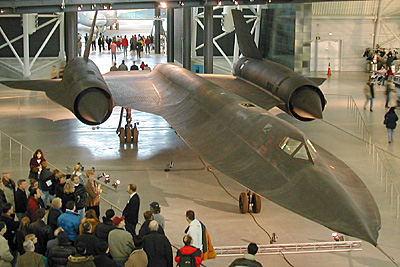
Even now, after 30 years in service, the SR-71 has looks and performance emingly borne in the 21st century.
The Blackbird upon entering the museum.
Developed by a team led by Kelly Johnson at Lockheed's Skunk Works, the SR-71 was designed as a strategic reconnaissance aircraft to succeed the U-2. Although detailed design work began in 1959, the US Government did not formally acknowledge the existence of the SR-71 until 1964. By this time the aircraft had been evaluated as a possible experimental all-weather interceptor in the Improved Manned Interceptor programme. The three aircraft that had been provisionally ordered for the USAF were designated YF-12A for the duration of the programme, and were later allocated to the joint NASA/USAF AST (Advanced Supersonic Technology) programme. Production of the the SR-71 began in 1963 and deliveries began to the 4200th Strategic Reconnaissance Wing in 1966.
Country of origin: USA
Type: strategic reconnaissance aircraft
Powerplant: two 14,742kg (32,500lb) Pratt & Whitney JT11D-20B bleed-turbojets
Performance: maximum speed at 24,385m (80,000ft) more than 3219km/h (2000mph); ceiling in excess of 24,385m (80,000ft); standard range 4800km (2983 miles)
Weights: empty 27,216kg (60,000lb); maximum take-off 77,111kg (170, 0001 b)
Dimensions: wingspan 16.94m (55ft 7in); length 32.74m 107ft 5in); height 5.64m (18ft 6in); wing area 167.22sq m (1800sq ft)
Specs and description from: Attack and Interceptor Jets by Michael Sharpe (Fiedman/Fairfax, 1999, ISBN: 1-58663-301-S), a handy book covering 300 aircraft.
WWI
WWII
Japan: Kawanichi N1K2-Ja Shinden Kai (George)
US: Curtiss P40 Tomahawk
Post WWII
US: Northrop N-1M Flying Wing
Other
UHC Displays
Germany: Focke-Wulf FW-190F
Germany: Arado AR-234B
Germany: Junkers JU-52/3m
Germany: Focke-Achgelis FA-330A
Germany: Rheintochter R1 Anti-aircraft Missile (Rhine Maiden)
Japan: Kawasaki Ki-45 Kai Toryu (Nick)
Japan: Aichi M6A1 Seiran
Japan: Kugisho Ohka Model 22 Cherry Blossom
US: Vought F4U Corsair
US: Lockheed P-38J Lightning
US: Boeing B-29 Superfortress "Enola Gay"
US: Grumman F6F Hellcat
US: Republic P-47D Thunderbolt
UK: DeHavilland DHC-1A Chipmunk
US: Lockheed SR-71 Blackbird
US: Space Shuttle "Enterprise"
US: Lockheed Martin X35b Joint Strike Fighter
Back to List of Historic Sites
Back to Travel Master List
Back to MagWeb Master List of Magazines
© Copyright 2004 by Coalition Web, Inc.
This article appears in MagWeb.com (Magazine Web) on the Internet World Wide Web.
Other articles covering military history and related topics are available at http://www.magweb.com